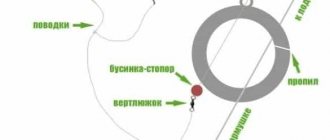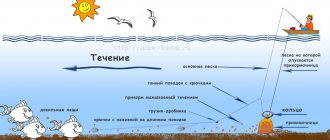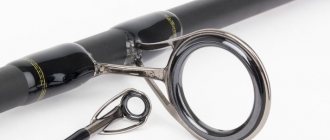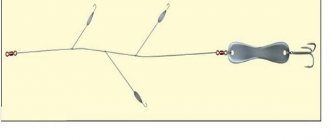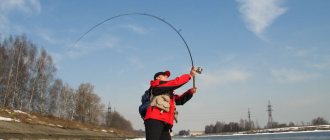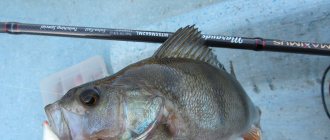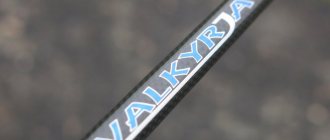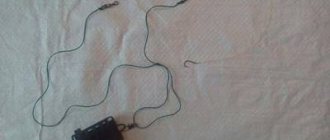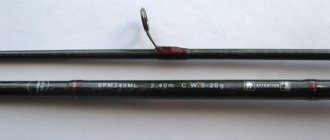I receive a very large number of questions about various aspects of spinning fishing, both to the editorial office of our newspaper, and in Internet conferences and by e-mail. Since many questions with minor variations are asked repeatedly, there is probably every reason to systematize them and from time to time organize a kind of “press conference” on the “Spinning School” page. Today I will try to answer the most frequently asked questions related to spinning rods.
Is the number of elbows in a spinning rod critical?
There are two extremes here. For some reason, some are sure that each connection negatively affects the working properties of the spinning rod, therefore, the fewer of these connections, the better it is. Others, on the contrary, believe that the number of knees has a minimal effect on the merits of a spinning rod.
Although in such cases it is customary to say that the truth lies somewhere in the middle, I am more inclined to share the position of supporters of multigenerationality. At least, as much as I have fished with 3-4-arm spinning rods, I could neither objectively nor subjectively find or feel any significant flaws in them. Therefore, I don’t see much point in the one-parters that are popular in America, even if they are 6-7 feet long. And spinning rods with a length of 11 feet or more are more justified in a three-leg version.
It is worth noting here that we are not currently comparing plug-in spinning rods with telescopic ones, since a comparison of all the most significant characteristics will not be in favor of the latter. Moreover, in my opinion, even a plug-in spinning rod of the “travel” type (with the number of legs from four or more) is still preferable to a “telescope” with the same number of sections, in all respects - both in strength and sensitivity.
Spinning rod length
On average, the normal length of a spinning rod is 2-3 meters. If you are buying your first spinning rod, choose a rod 2.4-2.7 meters long, this is the best option for you. If you prefer fishing from the shore on a large body of water, purchase a 3-meter long rod. But for small rivers you should not take a spinning rod longer than two meters. The length of the rod affects the casting distance, the movement of the spinning rod across the pond, the quality of fishing, and how quickly you get tired. Therefore, for fishing from the shore, buy long rods (unless, of course, you are fishing on the bank of a narrow river). These rods are also great for fishing from a boat.
As for short spinning rods, it has only one advantage - mobility and compactness.
Of course, the length of the spinning rod is selected depending on the type of fishing. Rods with a length of 2.4-2.7 meters can be called universal. Spinning rods with a longer or shorter length are more special, designed for a specific type of fishing and a specific type of reservoir.
If the length on the rod is indicated not in meters, but in feet, you simply multiply the indicated figure by 30cm (approximately). The result is the length in meters, plus a couple of centimeters. It is much easier to choose a spinning rod if you know where you will be fishing (from a boat or from the shore) and what body of water your fishing will be on.
For fishing from a boat, choose a spinning rod up to 2.4 m; such a spinning rod is easier to handle. For fishing from the shore, it is better to choose a spinning rod with a length of 2.7 meters. If you are going to fish both from a boat and from the shore, buy a rod 2.3-2.6 meters long. Although it would be more successful to purchase two spinning rods - separately for fishing from a boat and separately for fishing from the shore.
How important is the correct placement of the guide rings relative to the “seam” of the spinning rod blank?
Until recently, few people were interested in this question. Moreover, most of us didn’t even know that there is a so-called “seam” on the spinning blank. However, the problem of the “seam” was touched upon several times in various media, and, as a result, now one should not be surprised when, before purchasing a spinning rod, it is checked for the correct installation of the rings - taking into account the line of the “seam”.
Interest in the “seam” is due to a phenomenon that is sometimes called “radial anisotropy”: the strength of the blank’s resistance to bending differs slightly depending on the direction of this bend. And if suddenly the guide rings are mounted haphazardly, this is said to threaten a lot of troubles - from deterioration in casting accuracy to a persistent tendency for the knees to rotate in the connection.
There was a period when I myself meticulously checked the position of the “seam” on spinning rods, but then it suddenly turned out that some of my spinning rods, which I have been successfully fishing with for many years, did not pass the “seam test”. Then it became even more clear that some companies, which produce, among others, high-end spinning rods, completely ignore this issue - and, it seems, deliberately. As it turned out, everything turned out to be much less dramatic, and if attention should be paid to the position of the “seam”, it was not in the first place. In addition, the blanks of some spinning rods are made using “seamless” technology, and in many others, the radial anisotropy is rather weakly expressed.
Arrangement of rings on a “long-range” feeder rod. Part 2.
HomeArticlesAll articlesArticle
Fedorov
Rice. 1
I was not going to write this part because in the first part I set the task of showing how to calculate the location of the first (input, bottom) ring. This is important because the initial data for any arrangement of rings on any rod are its length and the distance from the input ring to the tulip. That's why I drew the reader's attention to calculating the position of this ring. But the manufacturer decides how to arrange the remaining rings himself. There are several such methods. All of them pursue two goals - to evenly distribute the load on the form and to extinguish the spiral of the cord. That is, the points at which the rings will be installed are calculated. Taking any branded rod, removing the ring map from it and thinking about it, you can find the formula by which these rings are arranged. (Of course, if they were not placed along a string with knots). To do this, four operations of arithmetic are enough.
After this, a method is selected for extinguishing the spiral of the cord and delivering it to the tulip. This is a “cone” and a “new concept” and all sorts of other concepts, of which there are as many as there are professional rodbuilders. It's just that some methods are better known, others less.
Take from the store two fishing rods with identical characteristics from the same manufacturer and the same price category , but different series, and compare. You will see that while the positions of the input rings are generally the same, the positions of the others and their sizes (and sometimes their numbers) are different. Sometimes rod blanks are painted in different colors. There's nothing to be done - the manufacturer needs an assortment. Then the buyer can snag not one, but a pair, or even better, three almost identical rods. For example, on one rod I have a No. 25 ring second from the bottom, and on the second one a No. 20 ring. On one, the inner diameter of the tulip is 4 mm, on the second – 3 mm. One has 14 rings (without a tulip), the second has 13. Despite the fact that the entrance rings on both are No. 30 (Fig. 2). That is, the rods differ only in the arrangement of the rings.
Rice. 2
And if one rod throws a little further, it is due to a longer handle, and not due to the placement of rings or the color of the blank. Moreover, there is no ideal placement formula. Otherwise everyone would just use it. You can reduce the friction of the line on the guides to a minimum, but this will deteriorate the balance of the rod and vice versa. The only thing we can pay attention to when purchasing is the distance of the input ring from the coil, and the internal diameter of the tulip. It should not be less than ~3 mm, otherwise the shock leader assembly will quickly break. Otherwise, regarding the placement of rings, you have to rely on the professionalism of the manufacturer. The truth will become clear only on the shore.
But Dima Salapin reprimanded me, writing in the comments: “There is not enough continuation for the rest (except the first) rings.” Guilty. I'm correcting myself. I just don’t know who needs it. Unless to the same rodbuilders. However, I respond to criticism.
Since the feeder was invented by the British, such standards in the production of rods as length and test are traditionally tied to the English system of weights and measures. That is, to feet, inches and ounces. For example, standard rod lengths are multiples of ~1 foot (~30 cm), and standard test is ~1 ounce (~28 g). According to the rules of feeder building (rodbuilding), the number of rings on the form must correspond to the length of the rod in feet. That is, on a rod with a length of, say, 4.2 m, 14 rings plus a tulip should be installed. Sometimes you come across rods with 13 rings plus a tulip. As a rule, this happens because, during conscientious marking, some ring got into the joint of the knees. Therefore, the markings were made for 13 rings. The British came up with an inertia-free coil, which, due to its design, determines the size of the input ring and the distance to it.
Everything taken together requires a certain arrangement of rings. This scheme, on the one hand, should ensure minimal friction of the cord; on the other hand, to evenly distribute and minimize the load on the form when casting. The abundance of available schemes is due to the fact that an ideal arrangement does not exist. For example, the oldest “cone” pattern provides minimal cord friction, but heavily loads the blank. It has been described inside and out and is still used today. An example is the Carp Pro Torus Carp Feeder series rods.
Let's take as an example a 4.2 m rod with a 60 cm long handle. We plan to use it with a 6000 reel. Therefore, as the lower (input) we will take ring No. 30, say, type Y (on a high leg). In the first part, we calculated that the distance of this ring from the reel should be ~60 cm, and from the butt (taking into account the length of the handle) - 1.2 m. Then, from the input ring to the tulip there remains: 4.2 m - 1.2 m = 3 m. Do you understand? The placement of the rings depends, among other things, on the length of the handle.
We will arrange the rings starting from the tulip. Moreover, each next ring should be 1 inch (~2.5 cm) further from the previous one than the previous one is from its previous one. Oh, I've piled on. In short, if, for example, the first ring is spaced from the tulip by an amount of "x", then the second from the first - (x+2.5 cm), the third from the second - (x+5 cm), the fourth from the third - (x+7 .5 cm). And so on. In this case, all 14 rings must be placed on the remaining three meters. We count:
x+(x+2.5 cm)+(x+5 cm)+(x+7.5 cm)+(x+10 cm)+(x+12.5 cm)+(x+15 cm)+ (x+17.5 cm)+(x+20 cm)+(x+22.5 cm)+(x+25 cm)+(x+27.5 cm)+(x30 cm)+
(x+32.5 cm) = 14x+227.5 cm = 300 cm.
Hence: x = (300-227.5): 14 = 5.2 cm. And this is nothing more than the distance from the tulip to the top ring. Then the formula for arranging tulip rings is: 5 cm ÷ 7.5 cm ÷ 10 cm ÷ 12.5 cm ÷ 15 cm ÷ 17.5 cm ÷ 20 cm ÷ 22.5 cm ÷ 25 cm ÷ 27.5 cm ÷ 30 cm ÷ 32.5 cm ÷ 35 cm ÷ 37.5 cm. Take a felt-tip pen and... go ahead and make markings on the rod. If some ring gets on the edge of the joint, it can be placed so that the braid of the joint is also the braid of the ring. Or move it a couple of centimeters. And at the same time move the neighbors a little. There won't be a big problem. If you need to move far, you can try to calculate the arrangement for 13 rings. Perhaps this arrangement will be perfect. If I'm not mistaken, the author of this scheme is the famous rodbuilder Kirkman. As you can see, if you approach the issue professionally, you can do without ropes and knots.
Now (as an option) we select rings, starting with input number 30. Next: No. 25, No. 20, No.!6, No. 12, No. 10 No. 8. then 3 rings No. 7 and 4 rings No. 6. The tulip is the same size. All. We have described only one of the existing methods. But there are others.
In conclusion, I note that the number of rings on a form of any length was determined a long time ago and does not cause disagreement. The difference between one arrangement method and another is only in the criterion or coefficient we chose to determine the distance from one ring to another.
Tags: feeder theory
2
Register or log in to comment.
Stepanych
-> Article
Arrangement of rings on a “long-range” feeder…
14.01.2021 07:37:25
The formula is correct. But then it’s a little different. Rings are usually designed for a specific reel and a specific form. The intersection of the centerline of the reel with the blank does not coincide with the end of the blank. As a rule, a ring called a “chok” is placed at the place of suppression. Ideally, the choke should be located at a certain point. If you take the blank in your hands in a horizontal position, holding it with your hand in the area of the reel seat, and lightly hit the end of the handle with your other hand in a horizontal position, the blank will begin to vibrate, but the “choke” should remain motionless. Calculations are made from the reel seat to the choke. After the choke, the rings are usually set to the same size.
Fedorov
-> Article
Arrangement of rings on a “long-range” feeder…
14.01.2021 15:11:19
Maybe. I'm not involved in rollbuilding, so I won't argue. But in my (possibly erroneous) understanding, the choke is the last ring that is involved in damping the cord spiral. And we put it where we need it. The closer the choke, the greater the total friction on the rings, but the less the load on the rod blank. And vice versa. Using the formula given in the first part, we can calculate that the center line of the 6000th reel intersects with the axis of the rod at a distance of ~110cm from the reel. Or 40÷50cm from the entrance ring (depending on its height). This is the minimum possible distance to the choke. That is, in principle, the second ring from the bottom can be the choke. Another question is how practical this is. And the maximum possible distance is when the choke is a tulip. This arrangement is called “cone”.
Does the diameter of the guide rings greatly affect the casting distance with a “meat grinder”?
When we used monofilament fishing lines, especially hard and thick ones, the spinning rod’s range greatly depended on the size and geometry of the rings. Some friends and I once conducted a special experiment, comparing two spinning rods in action, which did not differ in anything except the rings. The difference in throw range reached fifteen meters. Therefore, at that time (fifteen to twenty years ago), many, including me, for fishing with a spinning reel, changed the standard rings to rings of increased diameter...
With the advent of soft braided fishing lines, the relevance of increasing the diameter of the rings has practically disappeared. Except that with a fresh (“untested”) FireLine there may be some problems due to its rigidity; for other cords, if there is a difference in range, it is practically not noticeable to the naked eye.
Types of ring arrangements on spinning rods without inertia
Let's consider the main types of arrangements based on the leader in the production of rings, the Japanese concern Fuji. Let us remember that this affects the throwing distance, the negative impact of excess mass on the blank itself, and bending strength.
And the cost of the rings themselves.
Straight cone. Fig.1. The simplest arrangement. Requires the least number of rings. Mainly used on spinning rods made of low graphite. Since more modular ones will simply break at a bend due to the small number of them. The sizes of the rings are large and despite the smaller number, their mass kills the dynamics of the blank. Most suitable for mono and coarse cords. The throwing range seems to have to increase, but the dead dynamics of the form reduce it. In terms of cost, due to the quantity and space, the frames are the cheapest. Plus probably only in winter. Fewer rings and a larger diameter means less ice. New Concept from Fuji. Fig. 2 Maximum unloading of the spinning rod tip is the main principle. Even despite the larger number of rings. The mass of the last all rings is often lower than one middle ring from the cone arrangement. The number of rings does not allow exceeding critical angles on the blank even from the most modular graphites. The most fashionable arrangement at the moment. The throwing distance when using PE cords is not affected. The frames of the input rings are higher, which ensures proper cord discharge. The cost is higher due to the quantity and more complex wound. Kirkman arrangement. Named after the famous American rodbuilder. The rings used are the same as in NK. They unload the form even more. And even more small rings. Looks a little wild live:-) There are fans in Russia. The placement according to the reviews allows you to make the most accurate throws and is least susceptible to clinging to any branches when moving along the banks of rivers. Despite such a miracle, the throwing range does not decrease. The principle of breaking the spring of the cord flying away from the meat works even better here than in NK. As Kirkman says, more friction on one ring is better than a little on all of them. Mainly used with thin PE and mono in UL. Untitled. Fig 4. The most popular arrangement among rodbuilders. Suitable for almost any type of cord and lines. And it probably absorbed all the advantages of previous arrangements. It is rightfully considered the longest-range. Rings are the same type as in NK. PE.Fig 5. Used mainly in marine spinning rods specifically for PE cords. The input ring is smaller than usual and stands further from the coil. Special frames of the rings practically eliminate overlaps of thin cords even on long spinning rods in strong winds. Shorter for the sea. :-). Rarely seen and have few fans. Many people change them to NK rings. Complaints about noise when casting even with fashionable expensive PEs and a decrease in casting range. Plus one - overlaps are reduced to nothing. The cost is significantly higher due to the tricky frames. Next time we'll look at the rings themselves... published
DEA
, for the site balansir.com
direct link to the article: Types of ring arrangements on a spinning rod under inertia-free
Is the “new concept” from Fuji as good as the advertising says?
About ten years ago I met a man while fishing who had a spinning rod in his hands with rather strange, by the standards of that time, rings. The ring closest to the reel was of medium diameter, the next one was noticeably smaller, and all the rest were very small, and even on very short legs. Although this was not in Japan, but on the Klyazma near Petushki, the system for selecting and arranging rings was almost no different from the now universally known “New Concept” from Fuji.
To my natural question, the man replied that his rings weren’t worth it out of hand. He and his son experimented for a long time and came to the conclusion that by narrowing the amplitude of the scattering of the fishing line with the first two rings, some advantages could be achieved. I don’t remember which ones exactly, because initially I didn’t believe in the idea itself and didn’t listen to explanations. But people could then patent this very idea and, at least theoretically, get rich...
As for my current attitude towards New Concept, it is not entirely clear. If we take long-range as the main advantage of a spinning rod, then the “New Concept” does not provide real advantages over traditional rings. I didn’t strictly check it myself, but I know that such comparisons were made, and the result was either equal, or the spinning rod was thrown a little further with the old rings.
Another disadvantage of the “New Concept” is that it is less suitable for fishing in the cold. And the main thing here is not even that the small rings are more likely to become clogged with ice, but that the cord sometimes freezes to the form - since the legs on the upper rings are actually absent.
Now about the positives. The main one is unloading the form. The absence of parasitic weight in the upper part of the spinning rod definitely has a positive effect on its sensitivity and, in general, makes it possible to achieve the kind of action that was previously considered unattainable with a fundamentally the same form. Spinning rods with New Concept rings are more balanced and more comfortable to fish with. It behaves better when playing, since it experiences a lower twisting moment under heavy loads. So the “New Concept” is more of a plus than a minus.
Replacing the pass ring on a spinning rod
Let's start by actually removing the pass ring from the spinning rod. The operation is not difficult, but requires care and attention. There is no need to rush here, remembering that there are many other and more effective ways to damage a spinning rod blank than by removing the pass ring from it.
1. First of all, you should warm up the area where the ring is wrapped with a hairdryer to slightly soften the coating. I note that such local heating does not last long, and it is likely that during the dismantling process it will have to be repeated several more times. On inexpensive spinning rods, usually made in Southeast Asia, you may find that heating does not have any effect on the hardness of the coating. This means that the windings are not coated with traditional epoxy compounds, but with something completely different. In this case, you should abandon hopeless attempts to warm up, and simply go to step 2, since such “non-standard” coatings are quite easy, as a rule, to be removed even when cold.
2. Using a sharp knife or blade, we cut the coating of the winding, but only from the side of the foot of the pass ring (photo 1), since this is the only way we can guarantee that the spinning rod itself will remain undamaged. After making the cut, you must try to remove at least part of the coating. Usually this can be done without much difficulty. Then it is advisable to find the tip of the thread leading to the end of the winding. If this happens, then all that remains is to simply unwind this thread, while the remnants of the winding coating will peel off. If for some reason this does not work out, then you will have to remove the coating in parts, making additional cuts and periodically heating the area of the wrapping with a hairdryer.
3. Be that as it may, after removing the winding and removing the pass ring, there are still coating residues on the spinning rod blank, which also need to be gotten rid of. This is usually done with the help of a hairdryer; you can also use alcohol as a “softener”, but only after making sure that it does not damage the coating of this particular spinning rod blank. As a tool for scraping off the remnants of the winding coating, you should not use very hard and sharp objects - for example, metal ones. It is better to use softer materials - wood, plastic - to avoid, again, damage to the coating of the form. For example, children's counting sticks are good for these purposes.
4. So, the old guide ring has been dismantled, and the surface of the spinning rod blank has been cleaned of the winding and its coating. However, it is still too early to start winding a new ring; you still need to prepare it.
Firstly, it is highly advisable to grind off the edge of the ring foot - for a more convenient and painless entry of the thread into it (photo 2). Initially, this place on new guide rings does not smoothly fade away (photo 3), and for this reason, certain difficulties may arise when winding - and the larger the ring, the greater the difficulty. It is, of course, better to perform this operation on an emery wheel, but if we are talking about a single pass ring, then there are no particular problems in doing it manually.
Secondly, it is also a good idea to adjust the lower surface of the foot of the guide ring directly to the place on the spinning rod form where it will be installed. This is not at all difficult to do, after first wrapping the non-working side of a small piece of medium-sized sandpaper around the spinning rod blank in the desired area (photo 4). A delicate adjustment operation will allow you to remove small burrs on the lower edges of the foot and provide a larger area of contact of the guide ring foot to the spinning rod blank.
And thirdly, the access ring must be temporarily secured at the selected location. If we are talking about replacing the ring on the butt leg of a spinning rod or completely replacing the throughput rings on a spinning rod, this can easily be done using a soft silicone ring, cut from a tube of a suitable diameter, pulled away from the edge of the foot. And when part of the winding sufficient to fix the ring on the spinning rod blank has already been completed, the ring is cut off. But when it is necessary to replace one passage ring located between other rings, fixation in this way, alas, is impossible. In this case, to temporarily hold the ring in the right place, you can use a narrow strip of masking tape or electrical tape, or even just a small-diameter rubber band, previously folded several times.
5. A little about the choice of threads for winding the legs of the pass ring.
The best option is those specially designed for these purposes (photo 5), but you cannot buy them in any store. In general, it is extremely difficult to buy them in any store in our country. This is the harsh reality. But this does not mean that you cannot use some other threads. In principle, any synthetic thickness in the region of No. 50 according to the sewing classification will do. It should only be taken into account that the threads should not be fleecy. In addition, if we are talking about “professional” large-capacity bobbins, you need to be 100% sure that these threads are not impregnated with anything. The fact is that some of these threads are treated, for example, with silicone - for better glide, and silicone with coatings for rod windings (at least with those that are most often used for these purposes - based on epoxy resin) “is not friendly "
6. As for the winding process itself, then, of course, you can get smart and do it completely “by hand”, i.e. without using any devices to maintain constant thread tension and fix the spinning rod blank. But it’s still better to take on the task of making basic equipment. Moreover, it is really offensively simple. For example, as a “bed” for a spinning rod, you can use an oblong box made of thick cardboard - for shoes, say, etc. All you need to do with it is to make two shallow V-shaped cuts at the ends and reduce the height of one of the longitudinal walls on the side where the thread will approach the spinning rod blank by an amount equal to or slightly more than the depth of the cutouts at the ends.
The device for maintaining thread tension is even simpler: the thread is passed through the pages of some thick book, the tension will depend on the number of pages on top. It is advisable to place the spool of thread itself in some kind of bowl so that while winding the thread it does not jump around wherever and however necessary (photo 6).
Fuji rings - is there really no alternative to them?
In fact, for many spinning players, other rings do not seem to exist. And, probably, there is a great rational grain in this. You can, for example, remember the Pacific Bay rings or some others, but Fuji is still considered by most of us to be a higher class. And the point here is not only in the promotion of the brand.
At the same time, I perfectly understand that for many of our readers it is more important to know not what makes Fuji rings good, but whether any other rings can serve as an acceptable replacement for them? We are talking here about economy class rings, which are equipped with relatively inexpensive spinning rods.
I could refer to my own experience, but it is still not entirely indicative. In my practice, there have been no cases when rings (not Fuji) based on aluminum oxide and SiC were rubbed with braided cords, although I have fished and fish very actively with many spinning rods with such rings, but my friends have had such cases, and this is symptomatic.
Having summarized this kind of information, I am inclined to conclude that among the rings of unnamed origin sometimes substandard items slip through. Moreover, for example, five spinning rods of the same series with rings do not have the slightest problem, while the sixth suddenly develops grooves on the “tulip” or, what is even more significant, the “tulip” remains smooth, but on one of them subsequent rings show obvious signs of wear.
Thus, the main advantage of Fuji rings, in my opinion, is the positive predictability of their properties, and not in these properties themselves. Well, Fuji rings on spinning rods from the middle price class and above are justified. This is approximately 130-140 dollars and so on.
BA-BANG - ACROSS THE ENTIRE RIVERO. Kapitanov
You call a friend on his mobile phone, but he is not available, the connection does not reach him. Maybe at that moment you did not learn something interesting or extremely necessary, you did not receive either information or satisfaction. So every day spinners catch less fish than they could catch. The reason is the same: they don’t bother her. I have this idea about this - I want to catch everything. Well, I don’t like to limit myself. And I can’t afford to catch even one less fish than I could!
In our case, we are not talking about distances of many kilometers. Imagine that your cast rarely happens beyond 80 meters, and these 80, I tell you, are yesterday. Both one hundred and one hundred and fifty meters from the shore you can perfectly feel the bottom, carry out high-quality wiring and are guaranteed to catch fish. Pisces - she doesn’t care how far you are from her. Maybe she’s even glad that you’re not looming before her eyes.
Do you remember what makes a long cast? I remember.
Spinning
Go to any decent store, they are full of spinning rods. They are of different heights, with different tests and a significant difference in price. Fortunately, the price of a spinning rod is not a limiting factor in its range. And among the inexpensive spinning rods there are many “long-haulers”. For obvious reasons, the spinning rod itself does not indicate the distance to which it sends bait, and this cannot be determined “by shock” either. But trusting someone in this matter can lead to incompetence.
It’s rare that a spinning player gets all the juice out of his spinning rod. And it’s unlikely that he knows anything about the power contained in the form. Most of us have this attitude towards spinning rods: we are afraid to blow on them again. But I do not advocate exceeding the manufacturer’s recommended weight limits for casting baits, not at all. The ability to make the entire form work while casting is what I mean.
We have heard a lot about spinning rods that almost “throw themselves.” I can’t imagine: a spinning rod that casts for me. I will say this - fishing is not a relaxed parade along the shore, it is hard work and casting with all your might.
Yes, the placement of the guides affects the casting distance, and sometimes significantly. But it’s difficult with rings—doubts constantly haunt you, and often there is a desire to remove, rearrange, or polish something. It’s only later that you understand: ah... this time it’s in vain. I am armed with an interline spinning rod*. To some extent, it relieves me of doubt - dozens of “rings” are located inside the blank of this spinning rod! And I assure you, the “interline” is able to amaze the imagination precisely with its casting range, which can only be called into question “purely theoretically.”
Why I adore the very concept of “range” is because it contains specifics. One hundred meters, one hundred and ten - everything is clear and understandable. And what about the sensitivity there, the bitingness, sonority, “malice”? How is “spitefulness” measured? In rubles?
Leaving the rubles alone, I draw your attention to the main thing. A long cast can only be considered truly long when you can take advantage of it. I use spinning rods with heights ranging from 270 to 330 cm. A difference of 60 cm results in a 15-20 m gain in casting distance. And if I need longer spinning rods - 400 cm and above - I will fish with them. I decide for myself how to fish, and I’m not afraid to seem like a black sheep. But the structure of the spinning rods is different, and, accordingly, the casting technique is different, but the technique itself does not distinguish this difference.
Coil
The reel requires perfect line laying. This is perhaps the most important thing, but not everything. A larger spool (not depth, but size) is definitely more profitable than a smaller one. Just don’t forget about the input ring on the spinning rod, it’s not rubber - and it must fit.
And again about the rings. And again the desire to polish something. Polishing, although it does not significantly add dividends, is nevertheless not accidental. The struggle for casting distance is a struggle with friction forces. Another method of combating friction will come in handy here. It consists of the following: before casting at a distance, the reel spool is set to its highest position, and if this suddenly does not increase the casting distance, then at least you will observe one of the rules of good manners.
fishing line
I use braided cord. And although the casting range is higher with a regular fishing line, the fishing line not only conceals bites, but also makes it difficult to retrieve the bait at a distance of over 80 m.
The cords themselves are so different that not all of them are destined to fly. And, in addition, we must not forget about the impact of baits, which in our case are usually heavy, and about the negative air temperature, which, however, will remind you of itself. Why is it difficult to recommend specific brands of cord? For two reasons: none of the brands is consistent in either quality or diameter. And yet, I would highlight several cords that suit me - those that are both long-range and practical.
1. TUF LINE XP 15Lb - in terms of price/quality/casting distance ratio, there is no equal to this cord today. In addition to TUF LINE, the very similar Power Pro 10-15Lb is also suitable.
2. And “made in Japan” cords: YGK PE super 15Lb and Gamakatsu G-power (of different diameters).
Just in case, I would like to clarify the details. Firstly, the cord must be smooth (without sagging), but this only applies to Power Pro.
As for “made in Japan”, not everything is suitable here either. There is, for example, the Salmo Braid Elite cord - but it is not suitable for long casts because it is too soft. This threatens with such troubles as frequent “beards”, which cannot be avoided. Even reels with the most even line laying will not protect against this.
And once again about friction. Listen to the noise with which the fishing line breaks out, the whistle with which the lead cuts the air. We can and must reduce this friction. Perhaps the most effective lubricant is synthetic oil for bearings of multiplier reels. It is produced under different brands, for example: Rocket Oil (ABU Garcia) and some others.
Loads
For fishing, and I fish with jigs, I rarely use weights lighter than 30 g. Most often, from 30 to 50 g.
In any case, the main thing is to have a result. Everything has to be done meaningfully. Yes, today I can’t attach a 100-gram weight somewhere near Moscow, throw it somewhere far away and catch fish. But I’m happy with the compromise of 30-50 g. These weights allow you to both cast and catch.
Here is an example of an original solution for long-distance casting. The width of the river at the fishing site is 120 m and the depth is from 2 to 5 m. You know how it happens: there are local places where fish accumulate on the river, and the fish living compactly in such places simultaneously stay under both the right bank and the left, and in the middle. If only there was an edge or a hole. In most cases, a spinning player does not have the opportunity to jump from bank to bank, although he really wants to. And then he throws a 40-gram load across the river. Obviously, in this case, the wiring of the bait will have to be adapted “to new conditions” - in order to provoke the fish to bite. This is quite difficult to do, especially if the fish is inactive. But the second or twenty-second time, the wiring to the opposite bank will work, and then you will be able to appreciate your new capabilities and prospects.
Wind
We must cooperate with the wind. Ignoring the wind is wrong. With the help of the wind you can make ultra-long casts. For the wind to become an assistant, you should make it a rule to fish with your back to the wind. This is not about comfort, it’s just that the wind will cut us another 20-30 m of underwater pie. In some cases, just for this reason I make a decision in favor of one place or another. I follow the wind. When there is a tailwind, it is more advisable to launch the bait into a higher orbit in order to fully use the windage of the fishing line. The actual casting technique and its execution may vary.
Anton Ermakov: opening the line handle, lowers the bait to the level of the reel, moves the bait behind him with a smooth movement, and, maintaining the tension of the fishing line, makes a powerful cast, adding the movement of the body to the movements of the hands. At the same time, he doesn’t go out of his way, and after a few seconds he hooks the pike perch further than 100 meters from the shore.
Timofey Poddubny: opening the line handle, lowers the bait to the length of the spinning rod, raising it high, strictly above his head. At the same time, he aims the handle of the spinning rod at the point where he is going to throw. The supporting leg is slightly forward, and the body is tilted slightly back and to the side. Using the simultaneous movement of both hands and the “rolling” movement of the body, it makes a cast that is truly long and very accurate.
I, in turn, most often use this casting: opening the line handle, I lower the bait 2/3 of the length of the spinning rod. I throw it forward - and immediately, a little sharper, back, turning the body. And from behind my back, working with both hands and my whole body, I send the bait forward. The cast is long, although not very accurate.
Opportunities that we neglect can change our understanding of the usual state of affairs. And then there is a desire to look into the future in order to at least anticipate something. Hold on today to what will excite everyone’s imagination only tomorrow.
I don’t know how, but tomorrow’s casts will be very long. But they will bring something besides range. I want to be prepared for this.
Sport fishing No. 04 – 2005
Published with permission from the editors
Other articles in the SPINNING section:
I would like to buy an inexpensive, but highly sensitive spinning rod, is this realistic?
One of the most frequently asked questions. I’ll note right away that sensitivity, determined primarily by the modularity of the blank, is fully achieved only in expensive spinning rods - like Daiwa Sima or St. Croix Avid, for example. When they try to “squeeze out” the module in cheap Chinese spinning rods, outwardly such spinning rods look nice and, as they say, fit in the hand. But as soon as it comes to fishing, they die like flies...
There is nothing surprising here, since the fragility and vulnerability of “coal” increases with the growth of its elastic modulus, and not all manufacturers are able to effectively deal with this unpleasant pattern. In the cheap category, this problem remains insoluble.
In the intermediate category, options are possible, but here a lot depends on luck. So, for example, in the Jaxon Extreme series, a spinning rod with a test of 10-40 g turned out to be simply excellent - both “ringing” and not breaking. But the test up to 30 g - alas...
Finally, sensitivity can be understood in a significantly different way - not by “playing it back” into the hand, but by the visual perception of the tip. In this simplified case, there is little point in chasing expensive spinning rods. Spinning rods with a monolithic tip that are quite good for their price can be found at the same “Jackson” or “Mikado”.
Tips for Beginners
For those who do not have experience in fishing and do not know clearly where and what they will catch, the best option would be a spinning rod 2.1 meters long, of an average price category, with a dough of 10-30g. This fishing rod will not break and is suitable for any bait.
For those who prefer to fish on lakes (pike, for example), you need a more expensive spinning rod, costing from $50. Spinning rod length – 2.4-2.7 meters, test – 20-25g. For those who want to fish with a rubber band, a spinning rod 3 meters long, with a dough of 15-40g, is suitable. The price of such a spinning rod should be at least $70. For those who want a universal spinning rod for fishing in different bodies of water, a rod 2.7 meters long, with a test weight of 5-25, or 10-30g, is suitable. This spinning rod is suitable for fishing from a boat and for fishing from the shore, with any bait.
What type of spinning rod system should be considered the most universal?
This question is usually asked in cases where the goal is to choose one spinning rod for all or at least most fishing options. The craze that has taken place in recent years is now emphasized by the “fast” system - not that it has gone out of fashion, but for many the advantages of a more universal system are becoming more and more obvious. In some versions this system is called “regular”, in others – “moderate-fast”, in others – the formal designation may differ, but this does not change the essence. Spinning rods with this action make it possible to painlessly change from one bait to another (from a jig to a wobbler, for example); they are quite long-range and sensitive. Of the most popular spinning rods of this type, it is enough to name St.Croix Wild River or Daiwa Silver Creek-S with a dough of up to 21 g.
Is it possible to pull a fairly large fish out of the water by lifting it with a spinning rod on a fishing line?
If the breaking load of the fishing line you are using does not exceed the limit indicated on the spinning rod, then there should be no serious obstacles to such a technical action. The manufacturer seems to guarantee it. But even here you can find your pitfalls.
For example, the form says 6-10 lb., but you have a FireLine test cord of 10 lb. If this cord is “correct”, then, as is known, its actual strength turns out to be slightly higher than declared, sometimes one and a half times. So there may be trouble.
On those spinning rods where there is no information at all about the recommended fishing line strength, you have to use only common sense. In such situations, it is important not to make too sudden movements and avoid sharp angles between the fishing line and the spinning rod.
I saw an unusual spinning rod with a hexagonal blank, is it just for fun, or does it have a purpose?
Such spinning rods are actually produced, and, of course, not for fun. I tried one of them at work and overall I was very pleased with it, except for one small point. All the hexagonal spinning rods that I have ever seen are single-piece. I spoke about my attitude towards them a little higher. For most of us, this is not an option.
At the same time, I know of an attempt to make a two-legged spinning rod out of such a spinning rod, but this is technically difficult, and such processing will require additional investments, and a spinning rod already costs a lot of money.
The meaning of the hexagonal cross-section profile is to give the form maximum strength. Inside it there are also reinforcing partitions, which are hardly possible in an ordinary round form. So if detachable hex spinning rods of acceptable length suddenly appear, this may be in demand among power fishing enthusiasts.
Does it make sense to use particularly long spinning rods?
To a first approximation, as the length of the spinning rod increases, which is quite logical, the casting range increases. This is the main reason for the interest in long spinning rods. Although there is no clear quantitative relationship here, usually increasing the length of the spinning rod by one foot adds about five meters to the casting distance. This is true for a length range of seven to eleven feet.
I believe that eleven feet (3.35 m) is a reasonable limit for a regular spinning rod. There are also spinning rods of the “surf” class, intended mainly for fishing on the sea coast, but this is a completely different topic.
With a length of over eleven feet, the spinning rod becomes unreasonably heavy, loses sensitivity, and there is no longer any need to talk about a mandatory increase in range. And in some cases (for example, for G.Loomis spinning rods), the already considerable price rises sharply.
K. Kuzmin
Components of a spinning rod for casting distance
Increasing the casting distance in spinning fishing consists of many factors (often mutually exclusive), so the motto for completing a more harmonious and functional tackle is a compromise.
In the simplest version, the longer the rod, the further the cast. However, length is also a limiting factor: a very long rod, as a rule, is heavier, it is more difficult for them to cast on banks with abundant vegetation or while standing under a steep bank, and with a long rod it is less convenient to catch fish by hand. On the other hand, a long rod dampens the jerks of the fish better and makes it easier for them to “circle” coastal obstacles. In addition to these factors, do not forget that the comfort of fishing and casting distance are directly related to your anthropometric data. Let's say, a rod that is ideally comfortable for a spinning angler 190 cm tall may not be suitable at all for a person of similar build and physical strength, but 170 cm tall. The length of the rod handle is very important: too short will not allow you to create a sufficiently effective system of levers for the longest cast, and too long will interfere with wiring and cling to clothing.
Over several years of constant practice of winter spinning, I tried fishing with rods of various lengths. At first it was a Jig from Quantum at 2.89 m, then a 3-meter Szymanovskaya Catana, then a Magic Sea Trout made by A-elita (3.30 m), and now I’m fishing with an 11-foot Iron Feather II from Fenwick. In any case, the length of the rod for coastal fishing should be no less than 2.7 m and no more than 3.6 m.
It’s no longer a secret that the so-called “New Concept” offered by Fuji in the arrangement of guides on the blank provides a greater casting distance, and this is undoubtedly a positive factor. However, due to the fact that the total number of rings becomes larger, and their internal diameter is usually smaller, such rings freeze faster and more severely. When choosing a rod only for winter fishing at subzero temperatures, in my opinion, it is better to give preference to the traditional ring arrangement. If you have plenty to choose from, the best ones will be the ones with the maximum internal clearance.
Of course, you can combat freezing of rings of any diameter, but I have not yet developed any radical measures. If you treat the rings with silicone hand cream, they will freeze about the same, but it will be easier to clean the ice. As a rule, I just put up with this phenomenon, I just periodically immerse 50-60 cm of the rod tip into the water for a couple of seconds - the ice gets wet and you can cast. Don’t forget about matching the first ring from the butt (“input”) to the diameter of the spool.

